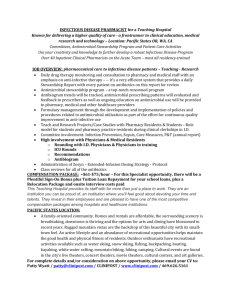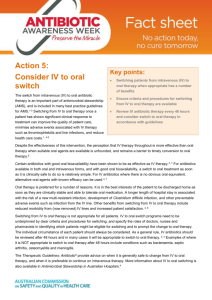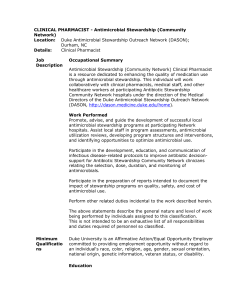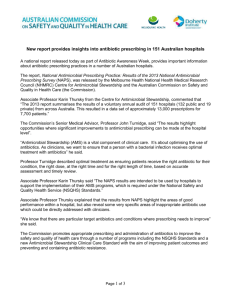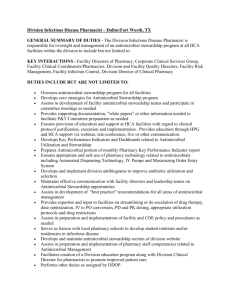AMS-Clinical-Care-Standard-Supporting-Evidence
advertisement
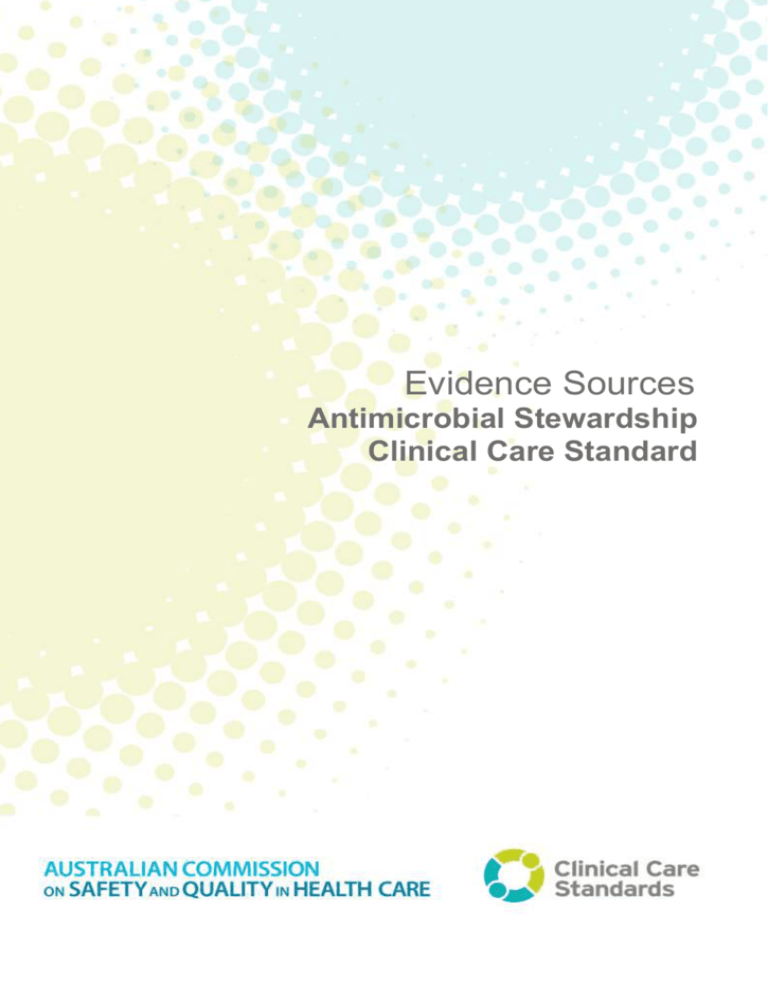
Evidence Sources Antimicrobial Stewardship Clinical Care Standard Evidence sources: Antimicrobial Stewardship Clinical Care Standard © Commonwealth of Australia 2014 This work is copyright. It may be reproduced in whole or in part for study or training purposes subject to the inclusion of an acknowledgment of the source. Requests and inquiries concerning reproduction and rights for purposes other than those indicated above requires the written permission of the Australian Commission on Safety and Quality in Health Care, GPO Box 5480 Sydney NSW 2001 or mail@safetyandquality.gov.au. ISBN: 978-1-921983-97-7 Suggested citation Australian Commission on Safety and Quality in Health Care. Evidence Sources: Antimicrobial Stewardship Clinical Care Standard. Sydney: ACSQHC, 2014. Acknowledgements Many individuals and organisations have freely given their time and expertise in the development of the Antimicrobial Stewardship Clinical Care Standard. The Commission gratefully acknowledges the contributions from members of the Antimicrobial Stewardship Clinical Care Standard Topic Working Group and other key experts who informed this document. Disclaimer The Australian Commission on Safety and Quality in Health Care has produced the Clinical Care Standard to support the delivery of appropriate care for a defined condition and is based on the best evidence available at the time of development. Health care professionals are advised to use clinical discretion and consideration of the circumstances of the individual patient, in consultation with the patient and/or their carer or guardian when applying information contained within the Clinical Care Standard. Consumers should use the information in the Clinical Care Standard as a guide to inform discussions with their health care professional about the applicability of the Clinical Care Standard to their individual condition. Evidence sources: Antimicrobial Stewardship Clinical Care Standard Evidence Sources – Antimicrobial Stewardship Clinical Care Standard The quality statements for the Antimicrobial Stewardship Clinical Care Standard were developed in collaboration with the Antimicrobial Stewardship Clinical Care Standard Topic Working Group and are based on best available evidence. Literature searches were conducted by Commission staff at different stages of development of the Clinical Care Standard. The initial search took place between June 2013 and August 2013. A draft evidence summary was prepared which was reviewed for completeness by the Antimicrobial Stewardship Clinical Care Standard Topic Working Group. A further search took place between August 2014 and September 2014 to identify any new evidence that may affect the relevance or validity of the final quality statements. The initial search was aimed at reviewing the evidence-base for each potential quality statement. As set out below, several steps were involved. The first step was to locate national clinical practice guidelines; if relevant, current, based on available evidence developed using systematic methods and endorsed by organisations, they would be the key sources of evidence. The second step was to locate other Australian guidelines, standards, policies, protocols, and international guidelines and standards. The third step was to identify highlevel evidence published after the release of the national clinical practice guidelines. Australian clinical practice guidelines, standards and policies were identified by searching: the clinical practice guideline portal of the National Health and Medical Research Council (NHMRC) websites of professional colleges and organisations websites of state and territory health departments and agencies internet search using various search engines. International clinical practice guidelines were identified by searching: guideline clearing houses such as the Agency for Healthcare Research and Quality (AHRQ), and Guidelines International Network (GIN) websites of guideline developers, such as the UK’s National Institute for Health and Care Excellence (NICE), Scottish Intercollegiate Guideline Network (SIGN). Other high-level evidence was identified by searching: the Cochrane Collaboration for systematic literature reviews and meta analyses medical literature databases (Medline, Embase) for systematic reviews and meta-analyses. A summary of evidence sources for each final quality statement is attached. 1 Evidence Sources: Antimicrobial Stewardship Clinical Care Standard Quality Statement 1 A patient with a life-threatening condition due to a suspected bacterial infection receives prompt antibiotic treatment without waiting for the results of investigations. EVIDENCE SOURCES Australian Guideline Antibiotic Expert Groups. Therapeutic guidelines: antibiotic. Version 15. Melbourne: Therapeutic Guidelines Limited; 2014 [cited November 2014]; Available from: http://www.tg.org.au International Guidelines Department of Health's Advisory Committee on Antimicrobial Resistance and Healthcare Associated Infection. Antimicrobial stewardship: Start Smart Then Focus. Guidance for antimicrobial stewardship in hospitals. England: 2011 [cited September 2014]; Available from: https://www.gov.uk/government/uploads/system/uploads/attachment_data/file/146981/dh_131181.pdf Dellit TH, Owens RC, McGowan JE et al. Infectious Diseases Society of America and the Society for Healthcare Epidemiology of America Guidelines for Developing an Institutional Program to Enhance Antimicrobial Stewardship. Clinical Infectious Diseases January 2007;44:159-177 [cited September 2014]; Available from: http://cid.oxfordjournals.org/content/44/2/159.full.pdf+html Dellinger RP, Levy MM, Rhodes A, et al. Surviving sepsis campaign: international guidelines for management of sepsis and septic shock: 2012. Critical Care Medicine. 2013;41(2):580-637 [cited September 2014]; Available from: http://www.sccm.org/Documents/SSC-Guidelines.pdf Additional Source New South Wales Clinical Excellence Commission. Adult Sepsis Pathway V2. Sydney: Clinical Excellence Commission; 2013 [cited September 2014]; Available from: http://www.cec.health.nsw.gov.au/__documents/programs/sepsis/july-2013/adult-sepsis-pathway-2013-v2-1.pdf. 2 Evidence Sources: Antimicrobial Stewardship Clinical Care Standard Quality Statement 2 A patient with suspected bacterial infection has samples taken for microbiology testing as clinical indicated, preferably before starting antibiotic treatment. EVIDENCE SOURCES Australian Guideline Antibiotic Expert Groups. Therapeutic guidelines: antibiotic. Version 15. Melbourne: Therapeutic Guidelines Limited; 2014 [cited November 2014]; Available from: http://www.tg.org.au International Guidelines Department of Health's Advisory Committee on Antimicrobial Resistance and Healthcare Associated Infection. Antimicrobial stewardship: Start Smart Then Focus. Guidance for antimicrobial stewardship in hospitals. England: 2011 [cited September 2014]; Available from: https://www.gov.uk/government/uploads/system/uploads/attachment_data/file/146981/dh_131181.pdf Dellit TH, Owens RC, McGowan JE et al. Infectious Diseases Society of America and the Society for Healthcare Epidemiology of America Guidelines for Developing an Institutional Program to Enhance Antimicrobial Stewardship. Clinical Infectious Diseases January 2007;44:159-177 [cited September 2014]; Available from: http://cid.oxfordjournals.org/content/44/2/159.full.pdf+html SARI Hospital Antimicrobial Stewardship Working Group. Guidelines for Antimicrobial Stewardship in Hospitals in Ireland. Dublin: Health Protection Surveillance Centre; 2009 [cited September 2014); Available from: http://www.hpsc.ie/hpsc/AZ/MicrobiologyAntimicrobialResistance/InfectionControlandHAI/Guidelines/File,4116,en.pdf Scottish Medicines Consortium / Healthcare Associated Infection Task Force. Antimicrobial Prescribing Policy and Practice in Scotland: Recommendations for Good Antimicrobial Practice in Acute Hospitals. Edinburgh: Scottish Executive; 2005 [cited September 2014); Available from: http://scotland.gov.uk/Resource/Doc/69582/0017099.pdf. Additional Sources Duguid M, Cruickshank M, editors. Antimicrobial Stewardship in Australian Hospitals. Sydney: Australian Commission on Safety and Quality in Health Care 2011 [cited September 2014]; Available from: http://www.safetyandquality.gov.au/our-work/healthcare-associated-infection/antimicrobialstewardship/book/ Davey P, Brown E, Charani E et al. Interventions to improve antibiotic prescribing practices for hospital inpatients (Review). Cochrane Database of Systematic Review. The Cochrane Library 2013 [cited September 2014]; Available from: http://onlinelibrary.wiley.com/doi/10.1002/14651858.CD003543.pub3/pdf 3 Evidence Sources: Antimicrobial Stewardship Clinical Care Standard Quality Statement 3 A patient with a suspected infection, and/or their carer, receives information on their health condition and treatment options in a format and language that they can understand. EVIDENCE SOURCES Australian Guideline Antibiotic Expert Groups. Therapeutic guidelines: antibiotic. Version 15. Melbourne: Therapeutic Guidelines Limited; 2014 [cited November 2014]; Available from: http://www.tg.org.au International Guideline SARI Hospital Antimicrobial Stewardship Working Group. Guidelines for Antimicrobial Stewardship in Hospitals in Ireland. Dublin: Health Protection Surveillance Centre; 2009 [cited September 2014); Available from: http://www.hpsc.ie/hpsc/AZ/MicrobiologyAntimicrobialResistance/InfectionControlandHAI/Guidelines/File,4116,en.pdf Additional Sources Arnold SR, Straus SE. Interventions to improve antibiotic prescribing practices in ambulatory care (Review). Cochrane Database of Systematic Reviews, 2009 [cited September 2014]; Available from: http://onlinelibrary.wiley.com/doi/10.1002/14651858.CD003539.pub2/pdf Australian Commission on Safety and Quality in Health Care. National safety and quality health service standards. Sydney: ACSQHC, 2011 [cited September 2014]; Available from http://www.safetyandquality.gov.au/publications/national-safety-and-quality-health-service-standards/ Medical Board of Australia. Good Medical Practice: A Code of Conduct for Doctors in Australia. Melbourne: MBA, 2010 [cited September 2014); Available from: http://www.medicalboard.gov.au/Codes-Guidelines-Policies.aspx 4 Evidence Sources: Antimicrobial Stewardship Clinical Care Standard Quality Statement 4 When a patient is prescribed antibiotics, whether empirical or directed, this is done in accordance with the current version of the Therapeutic Guidelines (or local antibiotic formulary). This is also guided by the patient’s clinical condition and/or the results of microbiology testing. EVIDENCE SOURCES Australian Guideline Antibiotic Expert Groups. Therapeutic guidelines: antibiotic. Version 15. Melbourne: Therapeutic Guidelines Limited; 2014 [cited November 2014]; Available from: http://www.tg.org.au International Guidelines Department of Health's Advisory Committee on Antimicrobial Resistance and Healthcare Associated Infection. Antimicrobial stewardship: Start Smart Then Focus. Guidance for antimicrobial stewardship in hospitals. England: 2011 [cited September 2014]; Available from: https://www.gov.uk/government/uploads/system/uploads/attachment_data/file/146981/dh_131181.pdf Dellit TH, Owens RC, McGowan JE et al. Infectious Diseases Society of America and the Society for Healthcare Epidemiology of America Guidelines for Developing an Institutional Program to Enhance Antimicrobial Stewardship. Clinical Infectious Diseases January 2007;44:159-177 [cited September 2014]; Available from: http://cid.oxfordjournals.org/content/44/2/159.full.pdf+html SARI Hospital Antimicrobial Stewardship Working Group. Guidelines for Antimicrobial Stewardship in Hospitals in Ireland. Dublin: Health Protection Surveillance Centre; 2009 [cited September 2014); Available from: http://www.hpsc.ie/hpsc/AZ/MicrobiologyAntimicrobialResistance/InfectionControlandHAI/Guidelines/File,4116,en.pdf Additional Sources Duguid M, Cruickshank M, editors. Antimicrobial Stewardship in Australian Hospitals. Sydney: Australian Commission on Safety and Quality in Health Care 2011 [cited September 2014]; Available from: http://www.safetyandquality.gov.au/our-work/healthcare-associated-infection/antimicrobialstewardship/book/ Australian Commission on Safety and Quality in Health Care. National safety and quality health service standards. Sydney: ACSQHC, 2011 [cited September 2014]; Available from http://www.safetyandquality.gov.au/publications/national-safety-and-quality-health-service-standards/ Davey P, Brown E, Charani E et al. Interventions to improve antibiotic prescribing practices for hospital inpatients (Review). Cochrane Database of Systematic Review. The Cochrane Library 2013 [cited September 2014]; Available from: http://onlinelibrary.wiley.com/doi/10.1002/14651858.CD003543.pub3/pdf 5 Evidence Sources: Antimicrobial Stewardship Clinical Care Standard Quality Statement 5 When a patient is prescribed antibiotics, information about when, how and for how long to take them, as well as potential side effects and a review plan, is discussed with the patient and/or their carer. EVIDENCE SOURCES Australian Guideline Antibiotic Expert Groups. Therapeutic guidelines: antibiotic. Version 15. Melbourne: Therapeutic Guidelines Limited; 2014 [cited November 2014]; Available from: http://www.tg.org.au International Guideline SARI Hospital Antimicrobial Stewardship Working Group. Guidelines for Antimicrobial Stewardship in Hospitals in Ireland. Dublin: Health Protection Surveillance Centre; 2009 [cited September 2014); Available from: http://www.hpsc.ie/hpsc/AZ/MicrobiologyAntimicrobialResistance/InfectionControlandHAI/Guidelines/File,4116,en.pdf Additional Sources Arnold SR, Straus SE. Interventions to improve antibiotic prescribing practices in ambulatory care (Review). Cochrane Database of Systematic Reviews, 2009 [cited September 2014]; Available from: http://onlinelibrary.wiley.com/doi/10.1002/14651858.CD003539.pub2/pdf Australian Commission on Safety and Quality in Health Care. National safety and quality health service standards. Sydney: ACSQHC, 2011 [cited September 2014]; Available from http://www.safetyandquality.gov.au/publications/national-safety-and-quality-health-service-standards/ 6 Evidence Sources: Antimicrobial Stewardship Clinical Care Standard Quality Statement 6 When a patient is prescribed antibiotics, the reason, drug name, dose, route of administration, intended duration and review plan is documented in the patient’s health record. EVIDENCE SOURCES International Guidelines Department of Health's Advisory Committee on Antimicrobial Resistance and Healthcare Associated Infection. Antimicrobial stewardship: Start Smart Then Focus. Guidance for antimicrobial stewardship in hospitals. England: 2011 [cited September 2014]; Available from: https://www.gov.uk/government/uploads/system/uploads/attachment_data/file/146981/dh_131181.pdf Scottish Medicines Consortium / Healthcare Associated Infection Task Force. Antimicrobial Prescribing Policy and Practice in Scotland: Recommendations for Good Antimicrobial Practice in Acute Hospitals. Edinburgh: Scottish Executive; 2005 [cited September 2014); Available from: http://scotland.gov.uk/Resource/Doc/69582/0017099.pdf. SARI Hospital Antimicrobial Stewardship Working Group. Guidelines for Antimicrobial Stewardship in Hospitals in Ireland. Dublin: Health Protection Surveillance Centre; 2009 [cited September 2014); Available from: http://www.hpsc.ie/hpsc/AZ/MicrobiologyAntimicrobialResistance/InfectionControlandHAI/Guidelines/File,4116,en.pdf Additional Sources Duguid M, Cruickshank M, editors. Antimicrobial Stewardship in Australian Hospitals. Sydney: Australian Commission on Safety and Quality in Health Care 2011 [cited September 2014]; Available from: http://www.safetyandquality.gov.au/our-work/healthcare-associated-infection/antimicrobialstewardship/book/ Australian Commission on Safety and Quality in Health Care. National safety and quality health service standards. Sydney: ACSQHC, 2011 [cited September 2014]; Available from http://www.safetyandquality.gov.au/publications/national-safety-and-quality-health-service-standards/ Davey P, Brown E, Charani E et al. Interventions to improve antibiotic prescribing practices for hospital inpatients (Review). Cochrane Database of Systematic Review. The Cochrane Library 2013 [cited September 2014]; Available from: http://onlinelibrary.wiley.com/doi/10.1002/14651858.CD003543.pub3/pdf Medical Board of Australia. Good Medical Practice: A Code of Conduct for Doctors in Australia. Melbourne: MBA, 2010 [cited September 2014); Available from: http://www.medicalboard.gov.au/Codes-Guidelines-Policies.aspx 7 Evidence Sources: Antimicrobial Stewardship Clinical Care Standard Quality Statement 7 A patient who is treated with broad-spectrum antibiotics has the treatment reviewed and, if indicated, switched to treatment with a narrow-spectrum antibiotic. This is guided by the patient’s clinical condition and the results of microbiology tests. EVIDENCE SOURCES Australian Guideline Antibiotic Expert Groups. Therapeutic guidelines: antibiotic. Version 15. Melbourne: Therapeutic Guidelines Limited; 2014 [cited November 2014]; Available from: http://www.tg.org.au International Guidelines Department of Health's Advisory Committee on Antimicrobial Resistance and Healthcare Associated Infection. Antimicrobial stewardship: Start Smart Then Focus. Guidance for antimicrobial stewardship in hospitals. England: 2011 [cited September 2014]; Available from: https://www.gov.uk/government/uploads/system/uploads/attachment_data/file/146981/dh_131181.pdf Dellit TH, Owens RC, McGowan JE et al. Infectious Diseases Society of America and the Society for Healthcare Epidemiology of America Guidelines for Developing an Institutional Program to Enhance Antimicrobial Stewardship. Clinical Infectious Diseases January 2007;44:159-177 [cited September 2014]; Available from: http://cid.oxfordjournals.org/content/44/2/159.full.pdf+html SARI Hospital Antimicrobial Stewardship Working Group. Guidelines for Antimicrobial Stewardship in Hospitals in Ireland. Dublin: Health Protection Surveillance Centre; 2009 [cited September 2014); Available from: http://www.hpsc.ie/hpsc/AZ/MicrobiologyAntimicrobialResistance/InfectionControlandHAI/Guidelines/File,4116,en.pdf Additional Sources Duguid M, Cruickshank M, editors. Antimicrobial Stewardship in Australian Hospitals. Sydney: Australian Commission on Safety and Quality in Health Care 2011 [cited September 2014]; Available from: http://www.safetyandquality.gov.au/our-work/healthcare-associated-infection/antimicrobialstewardship/book/ Davey P, Brown E, Charani E et al. Interventions to improve antibiotic prescribing practices for hospital inpatients (Review). Cochrane Database of Systematic Review. The Cochrane Library 2013 [cited September 2014]; Available from: http://onlinelibrary.wiley.com/doi/10.1002/14651858.CD003543.pub3/pdf 8 Evidence Sources: Antimicrobial Stewardship Clinical Care Standard Quality Statement 8 If investigations are conducted for a suspected bacterial infection, the responsible clinician reviews these results in a timely manner (within 24 hours of results being available) and antibiotic therapy is adjusted taking into account the patient’s clinical condition and investigation results. EVIDENCE SOURCES Consensus opinion: It should be noted that the Antimicrobial Stewardship Clinical Care Standard Topic Working Group agreed via consensus that the responsible clinician should review microbiology results within a time frame of 24 hours of results being available. Australian Guideline Antibiotic Expert Groups. Therapeutic guidelines: antibiotic. Version 15. Melbourne: Therapeutic Guidelines Limited; 2014 [cited November 2014]; Available from: http://www.tg.org.au International Guidelines Department of Health's Advisory Committee on Antimicrobial Resistance and Healthcare Associated Infection. Antimicrobial stewardship: Start Smart Then Focus. Guidance for antimicrobial stewardship in hospitals. England: 2011 [cited September 2014]; Available from: https://www.gov.uk/government/uploads/system/uploads/attachment_data/file/146981/dh_131181.pdf Dellit TH, Owens RC, McGowan JE et al. Infectious Diseases Society of America and the Society for Healthcare Epidemiology of America Guidelines for Developing an Institutional Program to Enhance Antimicrobial Stewardship. Clinical Infectious Diseases January 2007;44:159-177 [cited September 2014]; Available from: http://cid.oxfordjournals.org/content/44/2/159.full.pdf+html SARI Hospital Antimicrobial Stewardship Working Group. Guidelines for Antimicrobial Stewardship in Hospitals in Ireland. Dublin: Health Protection Surveillance Centre; 2009 [cited September 2014); Available from: http://www.hpsc.ie/hpsc/AZ/MicrobiologyAntimicrobialResistance/InfectionControlandHAI/Guidelines/File,4116,en.pdf Additional Sources Duguid M, Cruickshank M, editors. Antimicrobial Stewardship in Australian Hospitals. Sydney: Australian Commission on Safety and Quality in Health Care 2011 [cited September 2014]; Available from: http://www.safetyandquality.gov.au/our-work/healthcare-associated-infection/antimicrobialstewardship/book/ Davey P, Brown E, Charani E et al. Interventions to improve antibiotic prescribing practices for hospital inpatients (Review). Cochrane Database of Systematic Review. The Cochrane Library 2013 [cited September 2014]; Available from: http://onlinelibrary.wiley.com/doi/10.1002/14651858.CD003543.pub3/pdf 9 Evidence Sources: Antimicrobial Stewardship Clinical Care Standard Quality Statement 9 If a patient having surgery requires prophylactic antibiotics, the prescription is made in accordance with the current Therapeutic Guidelines (or local antibiotic formulary), and takes into consideration the patient’s clinical condition. EVIDENCE SOURCES Australian Guideline Antibiotic Expert Groups. Therapeutic guidelines: antibiotic. Version 15. Melbourne: Therapeutic Guidelines Limited; 2014 [cited November 2014]; Available from: http://www.tg.org.au International Guidelines Department of Health's Advisory Committee on Antimicrobial Resistance and Healthcare Associated Infection. Antimicrobial stewardship: Start Smart Then Focus. Guidance for antimicrobial stewardship in hospitals. England: 2011 [cited September 2014]; Available from: https://www.gov.uk/government/uploads/system/uploads/attachment_data/file/146981/dh_131181.pdf SARI Hospital Antimicrobial Stewardship Working Group. Guidelines for Antimicrobial Stewardship in Hospitals in Ireland. Dublin: Health Protection Surveillance Centre; 2009 [cited September 2014); Available from: http://www.hpsc.ie/hpsc/AZ/MicrobiologyAntimicrobialResistance/InfectionControlandHAI/Guidelines/File,4116,en.pdf National Institute for Health and Clinical Excellence. Surgical site infection – prevention and treatment of surgical site infection NICE; 2008 [cited September 2014]; Available from: http://www.nice.org.uk/guidance/cg74/resources/guidance-surgical-site-infection-pdf Scottish Intercollegiate Guidelines Network. Antibiotic prophylaxis in surgery. Scotland: SIGN; 2008 [cited September 2014]; Available from: http://www.sign.ac.uk/pdf/sign104.pdf Additional Sources Duguid M, Cruickshank M, editors. Antimicrobial Stewardship in Australian Hospitals. Sydney: Australian Commission on Safety and Quality in Health Care 2011 [cited September 2014]; Available from: http://www.safetyandquality.gov.au/our-work/healthcare-associated-infection/antimicrobialstewardship/book/ Davey P, Brown E, Charani E et al. Interventions to improve antibiotic prescribing practices for hospital inpatients (Review). Cochrane Database of Systematic Review. The Cochrane Library 2013 [cited September 2014]; Available from: http://onlinelibrary.wiley.com/doi/10.1002/14651858.CD003543.pub3/pdf 10 Evidence Sources: Antimicrobial Stewardship Clinical Care Standard

